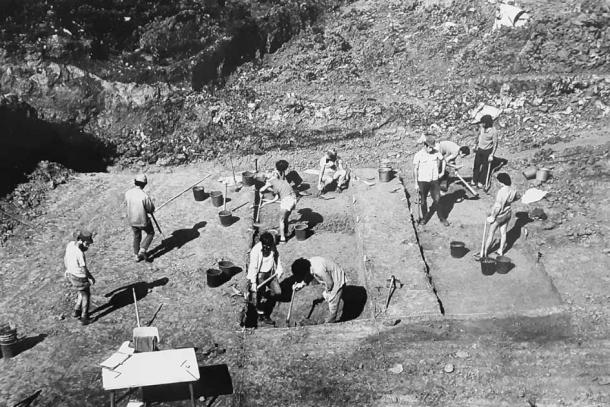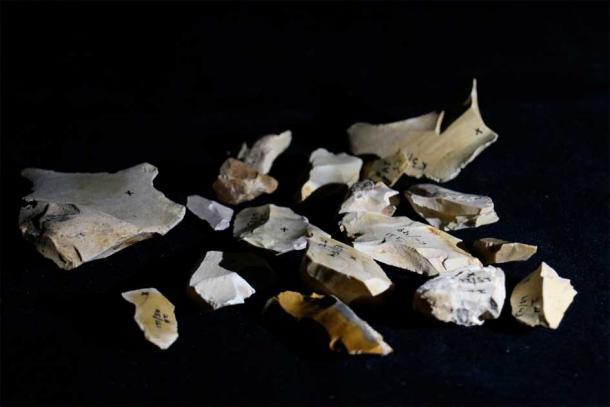
Human Fire Use Over A Million Years Ago Seems More Likely
There is no smoke without a fire, or so they say, and a group of scientists are applying this thinking to develop new methods to seek out when and where the earliest fire use was. And they have come up with some game-changing results.
The study of artifacts from the Evron quarry site, Israel, dated at somewhere between 1 million and 0.8 million years ago has revealed that it might be the site of the world’s oldest known campsite. Using a brand-new method of understanding the evolution of human pyro-technology by methods enhanced by artificial intelligence technology to assess flint tools and animal bones recovered from the site, we now have another piece in the puzzle about the human evolution story.
The new finding adds weight to recent claims of manmade fire at the Wonderwerk Cave in South Africa, dating to a million years plus. Thin evidence there indicated that humans could have been controlling fire far further back than ever evidenced before. But the Wonderwerk scientists knew they needed more evidence to back their work. The new methods could provide this.
The Cooking Hypothesis and the Human Relationship with Fire
Humans are the only species in the animal kingdom who cook their food and eat it, rather than eating it raw. But there is some theoretical evidence that extant members of the in the Homo genus ate cooked food too. And to do this they needed controlled heat.
The controlled use of fire by hominins has always been a source of fascination for evolutionary scientists, as the advent of the same allowed the increase of food and energy efficiency. Over time, this evolved into a smaller and more compact digestive tract, which freed up energy to allow the brain to expand.
- First Human Fire Starter Was 1.6 Million Years Ago, Scientist Says
- How Our Ancient Noses Drove Many Species to Extinction
This theory, called the ‘cooking hypothesis’, also allowed hominins to stay warm, craft advanced tools, and ward off predators. Cooking helped digest protein better and obtain nutrition from food in a more holistic manner. Cooking also helped up free up time, as average time spent in a day accorded to chewing was between 4 and 7 hours, which was an underutilization of intellect. According to Charles Darwin, fire and language are the two most significant achievements of humanity, and there is a reason for this.
For the same number of calories ingested, the body gets roughly 30% more calories from a cooked vs. its raw counterpart in oats, for example, or up to a whopping 78% in the case of an egg. Those who eat cooked food will gain more weight compared to those who eat uncooked food – the science is indisputable. Thus, it is literally possible to starve in the wild even after filling the stomach with raw food.
- Human bones in pot may reflect gruesome ritual conducted by army of Queen Boudicca
- The Ateshgah Baku Fire Temple: Built On an Azerbaijan Natural Gas Vent

Ancient artifacts first recovered from Israel's Evron Quarry archaeological site in the mid-1970s were analyzed with advanced computational models revealing evidence of the use of fire (Photo courtesy of Evron Quarry Excavation Archive/ University of Toronto)
Scientific Enquiry: Methodology and Combustion
This theory has faced familiar roadblocks though, mostly driven by a lack of evidence. There are only 5 other sites in the world with evidence of the use of fire as far back as 500,000 years old, others are around the 200,000 year mark. Reconstructing the relationship with pyro-technology requires visual identification of combustion and its effect on certain objects.
In this study published in The Proceedings of the National Academy of Sciences, the scientists from the University of Toronto, the Weizmann Institute of Science and Hebrew University have approached the conundrum in an interesting manner, paving way for future scientists to also utilize and enhance this method even further. The scientists from Israel’s Weizmann Institute of Science took the flint tools and the animal bones, combining AI and spectroscopy for archaeology to the finds in Evron Quarry. Using this they were able to “detect nonvisual traces of fire dating back at least 800,000 years” notes the release by the Weizmann Institute.
“The deep learning models that prevailed had a specific architecture that outperformed the others and successfully gave us the confidence we needed to further use this tool in an archaeological context having no visual signs of fire use,” adds Dr. Azuri.

Flint tools found at the Evron Quarry (photo by Zane Stepka / University of Toronto)
Dr. Filipe Natalio from Weizmann’s Plant and Environmental Sciences Department had previously collaborated with Dr. Ido Azuri of Weizmann’s Life Core Facilities Department, pioneering this method – this formed the basis of their collaboration on this study. The wavelengths of infrared absorbed by the artifacts were detected using a method called ‘Fourier-transform infrared (FTIR)’ spectroscopy.
“When we started this project,” says Natalio, “the archaeologists who’ve been analyzing the findings from Evron Quarry told us we wouldn’t find anything. We should have made a bet.”
These artifacts are believed to absorb UV rays and infrared radiation, that are both by-products of combustion. They then compared the artifacts to similar unburnt materials and found that the heating would have occurred at temperatures between 390°F (200°C) and 1100°F (600°C). Then, from the same sedimentary layer as the tools, the tusks of a large elephant like animal were analyzed, which had also been exposed to similar temperatures.
Moving Forward
The team concluded that the site’s inhabitants used the fire to cook meat. They also deduced that the site, 0.8 and 1 million years ago, was inhabited by our tool-making human ancestors, Homo erectus. This site was a difficult one to reach, with 750 square feet (70 sq. meters) of archaeological layer excavated to reach the artifacts, which were at a depth of 50 feet (15 meters) above sea level.
“It was not only a demonstration of exploration and being rewarded in terms of the knowledge gained, but of the potential that lies in combining different disciplines: Ido has a background in quantum chemistry, Zane is a scientific archaeologist, and Liora and Michael are prehistorians. By working together, we have learned from each other. For me, it’s a demonstration of how scientific research across the humanities and science should work,” concludes Natalio, who was very satisfied with the progress made.
Top image: Wood burning, human fire use could date back a million years. Source: nikkytok/Adobe Stock
By Sahir Pandey
References
Jackson, F. 2022. World's oldest campfire? Ancient flint tools and animal bones discovered in Israel show humans may have tamed fire as early as one MILLION years ago. Available at: https://www.dailymail.co.uk/sciencetech/article-10922739/Worlds-oldest-campfire-Ancient-flint-tools-humans-tamed-fire-1-MILLION-years-ago.html.
Mozter, P. 2022. An Innovative Method Detects a Nonvisual Traces of Fire That Has Been 800,000 Years Ago. Available at: https://www.natureworldnews.com/articles/51596/20220628/innovative-method-detects-nonvisual-traces-fire-800-000-years-ago.htm.
Stepka, Z., Azuri, I. et al. 2022. Hidden signatures of early fire at Evron Quarry (1.0 to 0.8 Mya). PNAS, 119 (25). Available at: https://doi.org/10.1073/pnas.2123439119.
University of Toronto News. 2022. AI-powered archaeology draws out hidden evidence of fire use by early humans. Available at: https://www.utoronto.ca/news/ai-powered-archaeology-draws-out-hidden-evidence-fire-use-early-humans
Weizmann Wonder Wander. 2022. The Heat Is On: Weizmann Institute Scientists Uncover Traces of Fire Dating Back At Least 800,000 Years. Available at: https://wis-wander.weizmann.ac.il/scientific-archaeology/heat-weizmann-institute-scientists-uncover-traces-fire-dating-back-least
















Comments
Yep, people like us, but way back then, when we knew different things, those things that we NEEDED to know to understand and survive in the natural world, where there is fire and a lot more. But today our minds are filled with a LOT-LOT more.
Nobody gets paid to tell the truth.
People really don't change much at all. That's why all members of the genus Homo deserve to be called 'human', whether living now or a million years ago.
If we do that, the use of fire way back then doesn't seem such a stretch of the imagination, which it shouldn't be. That accepting the likelihood of early human fire use is still a stretch in today's World merely illustrates that modern anthropological thinking hasn't entirely escaped the eugenicist attitudes of Occult-loving Victorian elites.
As people in general don't change much over time – we still want that which makes us happy, without getting too crazy about it, while many of us also tend to be naive and easily fall for tricks, looking back at our history as has been told from the ‘what seems more likely’ perspective, ...hmmm, may open up the biggest can of worms ever.
Nobody gets paid to tell the truth.